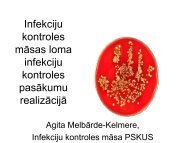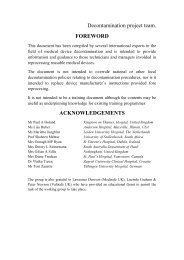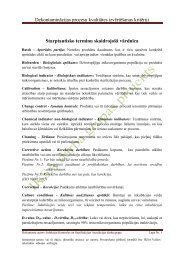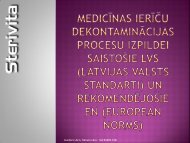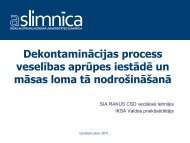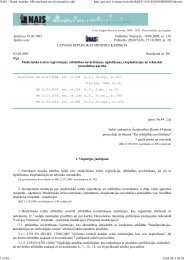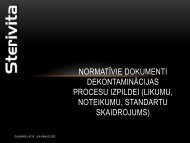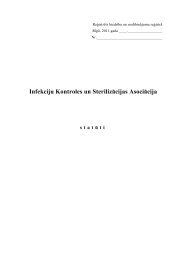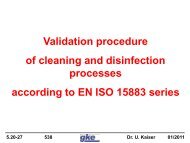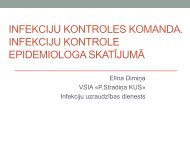Good morning ladies and gentlemen, It is my honour to ... - Sterivita.lv
Good morning ladies and gentlemen, It is my honour to ... - Sterivita.lv
Good morning ladies and gentlemen, It is my honour to ... - Sterivita.lv
You also want an ePaper? Increase the reach of your titles
YUMPU automatically turns print PDFs into web optimized ePapers that Google loves.
<strong>Good</strong> <strong>morning</strong> <strong>ladies</strong> <strong>and</strong> <strong>gentlemen</strong>,<br />
<strong>It</strong> <strong>is</strong> <strong>my</strong> <strong>honour</strong> <strong>to</strong> welcome you <strong>to</strong> the 12 th congress of the WFHSS.<br />
After the previous, successful conference, organized by SOBECC in<br />
Sao Paolo, we remain in the same language area. Beforeh<strong>and</strong> I would<br />
like <strong>to</strong> thank ANES, <strong>and</strong> Lu<strong>is</strong>a Nogueira <strong>and</strong> her team in specific, for<br />
the invitation, the perfect choice of location, the fluent cooperation,<br />
the exemplary organization, but most of all for the warm, Portuguese<br />
hospitality.<br />
As I already wrote in <strong>my</strong> welcome message: In choosing for Es<strong>to</strong>ril we<br />
make a date with h<strong>is</strong><strong>to</strong>ry because the Portuguese explorers were the<br />
first <strong>to</strong> cross the oceans <strong>and</strong> thus they started the process of<br />
interaction between the continents. From the 15 th century onwards,<br />
they determined <strong>to</strong> a large extent not only our view on the world, but<br />
also the other way round. In its domain the WFHSS <strong>is</strong> following in<br />
their footsteps by bringing <strong>to</strong>gether sterilization associations <strong>and</strong><br />
members of staff working in sterilization departments all over the<br />
world. In th<strong>is</strong> way we try <strong>to</strong> enhance the harmonization of<br />
decontamination practices <strong>and</strong> of the sterilization departments. Our<br />
aim <strong>is</strong>, by making the world of sterilization "smaller", <strong>to</strong> bring the<br />
basic right of every patient, <strong>to</strong> be treated with a medical device of a<br />
good quality, closer by. However, in contrast <strong>to</strong> the conqu<strong>is</strong>tadores,<br />
we do not intend <strong>to</strong> impose our philosophy <strong>and</strong> views. What we do<br />
want <strong>is</strong> <strong>to</strong> exchange information, present insights <strong>and</strong> ideas, <strong>and</strong> test<br />
these against other people’s opinion. We want <strong>to</strong> engage in a<br />
dialogue in which all parties invo<strong>lv</strong>ed are equal partners. Thus, it <strong>is</strong> a<br />
reactive model which can only work <strong>and</strong> hold out if it <strong>is</strong> reciprocal. In<br />
th<strong>is</strong> case, sterilization can make quick <strong>and</strong> “real” progress.
Also on national level a similar kind of interaction between the<br />
departments should be achieved. To realize th<strong>is</strong> <strong>is</strong> a task that belongs<br />
<strong>to</strong> the associations. They are in the best position <strong>to</strong> act intermediary<br />
because they are the most important carriers of information <strong>to</strong> the<br />
departments. <strong>It</strong> <strong>is</strong> mainly thanks <strong>to</strong> the associations that during the<br />
previous decades sterilization dramatically improved. In light of the<br />
growing knowledge <strong>and</strong> insights, the increasing quality claims which<br />
are in connection, amongst others, with the appearance of new<br />
forms of d<strong>is</strong>ease, the instrumentation which becomes more <strong>and</strong><br />
more complex, the increasing amount of surgeries, the rapidly<br />
evo<strong>lv</strong>ing hospital context, th<strong>is</strong> was <strong>and</strong> <strong>is</strong> no unnecessary luxury.<br />
Everyone who <strong>is</strong> a member of an association, will undoubtedly agree<br />
with th<strong>is</strong> <strong>and</strong> will confirm its importance for the progress of daily<br />
practice.<br />
Therefore, I would like <strong>to</strong> direct <strong>my</strong>self <strong>to</strong> those people in the<br />
audience who originate from those countries where no associations<br />
ex<strong>is</strong>t at the moment. I would like <strong>to</strong> ask them <strong>to</strong> do everything they<br />
can <strong>to</strong> found a national sterilization association. A collective approach<br />
<strong>is</strong> the best condition for individual progress. An old Chinese proverb<br />
that suits perfectly in th<strong>is</strong> context, says: “If you want <strong>to</strong> go fast, go<br />
alone. If you want <strong>to</strong> go far, go <strong>to</strong>gether”. The “higher” aim of an<br />
association has <strong>to</strong> be that each of her departments delivers at least a<br />
basic service <strong>and</strong> guarantees at least a basic quality.<br />
Peter Hooper recently <strong>to</strong>ld me that he was surpr<strong>is</strong>ed that “although<br />
he already v<strong>is</strong>ited a great deal of sterilization departments, he had<br />
never seen a department that <strong>is</strong> identical <strong>to</strong> another. They are all<br />
different”. Despite the fact that we draw on the same sources,<br />
namely directives, norms, guidelines, recommendations <strong>and</strong> more or<br />
less st<strong>and</strong>ardized trainings, it seems that the texts are divergently<br />
interpreted <strong>and</strong> thus differently put <strong>to</strong> practice. Sometimes
sterilization seems <strong>to</strong> be” A most individual expression of a most<br />
individual emotion”. Of course local fac<strong>to</strong>rs such as access roads,<br />
space available <strong>and</strong> resources play an important role. Nevertheless<br />
the question remains if we should not be searching for a consensus<br />
about what an ideal department can be <strong>and</strong> evo<strong>lv</strong>e in that direction<br />
Because for the moment the “state of art” in sterilization has various<br />
ends. Even if the roads are not the same, they should, eventually,<br />
converge in the same goal: the delivery of a reproducible, qualitative<br />
medical device, at the best price.<br />
Taking the first step <strong>is</strong> maybe the hardest one, but at the same time it<br />
<strong>is</strong> also the most important phase of the process. Progress must be<br />
made on the bas<strong>is</strong> of evidence, knowledge <strong>and</strong> experience or on a<br />
fundamental attitude like Immanuel Kant, an 18 th century German<br />
philosopher, described of: “Sapere aude” or “dare <strong>to</strong> know”. In other<br />
words progress must be made on the courage <strong>to</strong> l<strong>is</strong>ten <strong>to</strong> your own<br />
mind. I would like <strong>to</strong> add another dimension here: we also must have<br />
the courage <strong>to</strong> consequently implement our expert<strong>is</strong>e. Sterilization<br />
has need of th<strong>is</strong>, because sterilization has problems with letting go of<br />
traditions <strong>and</strong> habitual routines, with making the final step <strong>to</strong> a<br />
contemporary department. Two examples <strong>and</strong> questions at the same<br />
time: During <strong>my</strong> v<strong>is</strong>its <strong>to</strong> departments I often record that not all of<br />
the instruments are treated in the central department. The belief <strong>and</strong><br />
confidence in one’s own knowledge <strong>and</strong> skills must surely by now be<br />
big enough <strong>to</strong> adequately treat, for example, also the delicate<br />
ophthalmological instruments in the CSSD . And <strong>is</strong> it really necessary<br />
<strong>to</strong> build in a control of the control of the control Once again, we<br />
must be prepared <strong>to</strong> take up our responsibilities. Choosing for<br />
security should suffice. To maximize security <strong>is</strong> not what <strong>is</strong> required.<br />
<strong>It</strong> becomes time <strong>to</strong> red<strong>is</strong>cover the essence in sterilization.
In order <strong>to</strong> be able <strong>to</strong> do so, it <strong>is</strong> necessary that the department does<br />
not only have enough employees, but most of all has the appropriate<br />
employees. Because the human fac<strong>to</strong>r still <strong>is</strong> the fac<strong>to</strong>r with the<br />
greatest impact on the course of the process <strong>and</strong> thus on the final<br />
result. The latter <strong>is</strong> the result of teamwork. <strong>It</strong> <strong>is</strong> important that every<br />
employee can rely on h<strong>is</strong> colleagues <strong>and</strong> vice versa. Thus, we have <strong>to</strong><br />
hire employees which – apart of competence, as th<strong>is</strong> speaks for itself<br />
— have the right skills <strong>and</strong> attitude <strong>and</strong> are enthusiastic <strong>to</strong> work in<br />
sterilization. Th<strong>is</strong> <strong>is</strong> even more the case for the person in charge of<br />
the department. He or she has a big responsibility. Because the level,<br />
the perception, the appreciation of the department depend largely<br />
on the char<strong>is</strong>ma <strong>and</strong> the dynam<strong>is</strong>m of the manager! Besides<br />
selection, education remains, as already mentioned before, a basic<br />
element. The three level program of the WFHSS still <strong>is</strong> the model for<br />
th<strong>is</strong>.<br />
A good selection procedure undoubtedly has the side effect that<br />
“brain drain” can be prevented. The last <strong>is</strong> a phenomenon which<br />
recently struck me in several countries, especially with regard <strong>to</strong> the<br />
responsibles of sterilization departments. <strong>It</strong> <strong>is</strong> essential that<br />
sterilization keeps attracting also academics <strong>to</strong> preserve the<br />
scientific level <strong>and</strong> <strong>to</strong> build up credibility in the hospital. Having<br />
background information at one’s d<strong>is</strong>posal, having the opportunity <strong>to</strong><br />
increase knowledge <strong>and</strong> developing h<strong>is</strong>/her own personality, <strong>is</strong><br />
necessary <strong>to</strong> keep th<strong>is</strong> job fascinating <strong>and</strong> interesting. Also, the<br />
further integration of a department in a hospital can contribute <strong>to</strong><br />
th<strong>is</strong>. For quite a while sterilization <strong>is</strong> no longer an <strong>is</strong>l<strong>and</strong>. Making an<br />
important contribution <strong>to</strong> the success of the whole can work<br />
stimulating <strong>and</strong> contain new, attractive challenges. In th<strong>is</strong> way the<br />
department can, for example, play a bigger role in efficient hospital<br />
log<strong>is</strong>tics. Preparing “case carts” <strong>is</strong> an excellent <strong>and</strong> functional
example of th<strong>is</strong>. Furthermore, the CSSD as expert in the field of<br />
cleaning <strong>and</strong> d<strong>is</strong>infecting can not only play an important adv<strong>is</strong>ing, but<br />
also active role with th<strong>is</strong> kind of procedures on the nursing<br />
departments <strong>and</strong> outpatient clinics.<br />
Following the example of Diaz, Magalhaes <strong>and</strong> Vasco da Gama we <strong>to</strong>o<br />
should have the courage of exploring new terri<strong>to</strong>ries <strong>and</strong> push back<br />
our frontiers. Mental barriers have <strong>to</strong> be d<strong>is</strong>mantled <strong>and</strong> replaced by<br />
an openness of mind, which should make innovation <strong>and</strong> progress<br />
possible. An inqu<strong>is</strong>itive stance should stimulate us <strong>to</strong> look over the<br />
walls of the CSSD <strong>and</strong> lead <strong>to</strong> a better integration of the sterilization<br />
department in<strong>to</strong> the caring processes <strong>and</strong> in<strong>to</strong> the hospital.<br />
A congress <strong>is</strong> not only a forum where the present <strong>and</strong> the future<br />
world, industry <strong>and</strong> working field, science <strong>and</strong> sterilization practice<br />
come <strong>to</strong>gether but it <strong>is</strong> first <strong>and</strong> foremost a place where people can<br />
meet face <strong>to</strong> face. Th<strong>is</strong> provides an additional value, which cannot be<br />
realized by reading a scientific article.<br />
Therefore I trust that th<strong>is</strong> congress can once again become the<br />
meeting place of the sterilization world. Together we can determine<br />
the road ahead <strong>and</strong> navigate the state-of-the-art. We hope our 12 th<br />
congress will become an inspiring, scientific happening.<br />
Thanks for being here, for your support. Enjoy the conference,<br />
Wim Renders<br />
Brugge, 03/08/2011



